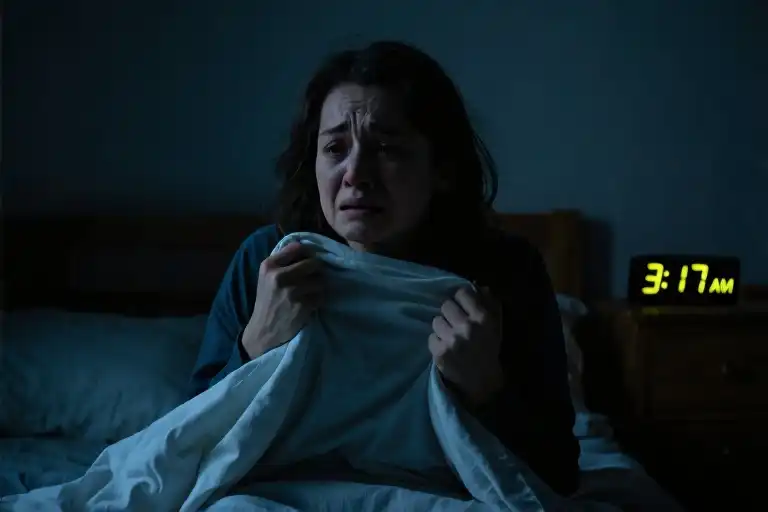The text came through at 3:17am, the blue light of my phone cutting through the darkness like a surgical instrument. “I’m having symptoms of depression. I’ve been diagnosed before.” My thumbs hovered over the keyboard, the weight of those words making my hands tremble. This wasn’t my first message about mental health to my spiritual teacher, but it was the most desperate.
By hour 72 of this latest episode, my body had become a collection of malfunctioning systems. A dull, persistent ache radiated from my abdomen – what doctors later explained was the brain-gut connection in recurrent depressive disorder gone haywire. The nausea came in waves, sudden and violent enough to leave me kneeling on cold bathroom tiles at unpredictable intervals.
Most disturbing was the mirror. My reflection stared back with dead eyes, the person I knew buried under some invisible weight. “Ghosting” my therapist called it later – that dissociation when depression makes your own face unrecognizable. The numbness started in my extremities, creeping inward until even crying felt like watching someone else’s breakdown from behind thick glass.
Recurrent depressive disorder operates in cruel cycles. Just when you think you’ve mapped the terrain of your particular darkness, it shifts. The third recurrence feels different than the first – not sharper, but heavier, like your bones have absorbed the weight of previous episodes. You develop a morbid familiarity with the symptoms even as they surprise you anew each time.
This was my third descent into the same psychological abyss, though I didn’t know then that research shows recurrent episodes often intensify physically. The stomach pain wasn’t psychosomatic – it was my vagus nerve screaming, my gut microbiome responding to the chemical imbalance. But in that moment, all I knew was the overwhelming need for someone to say “I see you” instead of “snap out of it.”
The message to my spiritual teacher was a Hail Mary pass. Years earlier, she’d spoken beautifully about darkness and light. Now I needed those words to become action. As I hit send, part of me still believed spiritual guidance could coexist with medical understanding of mood disorders. That hope lasted exactly 47 minutes – the time it took for her response to land like a lead balloon.”
The Anatomy of Drowning
The pain started as a dull pressure below my ribs, the kind that makes you check the calendar to see if it’s just that time of month. But calendars don’t explain why your hands suddenly weigh forty pounds each, or why brushing teeth becomes an Olympic-level achievement. By day three, the stomachache had sharpened into something that pulsed with my heartbeat – a cruel reminder I was still alive when all I wanted was to disappear.
Recurrent depressive disorder operates on its own mysterious timetable. Like a train that arrives unannounced, it doesn’t care if you’re mid-conversation or finally meeting a work deadline. The familiar signs rolled in: food tasting like wet cardboard, my bedroom walls seeming to breathe inward, that peculiar metallic smell that lingers in your nose during episodes. This would be my third major depressive episode in eight years – enough to recognize the patterns, never enough to build immunity.
What surprised me this time were the physical manifestations. The DSM might list ‘psychomotor retardation’ as a clinical term, but textbooks don’t prepare you for the actual experience of your nervous system slowing like a dying watch. I’d sit motionless for hours, acutely aware of dust motes drifting through sunlight while my limbs refused commands. My gastroenterologist later explained the gut-brain axis – how depression can literally twist your intestines into knots – but in that moment, it just felt like my body had become a haunted house where every system malfunctioned.
The mirror became enemy territory. Not in the body dysmorphia sense, but something more existential. My reflection didn’t look sad; it looked empty, like a mannequin version of myself with all the life drained out. I’d touch my face half-expecting the skin to crack like dry clay. When the suicidal ideation started – not plans, just intrusive thoughts about how easy stopping would be – that’s when I reached for my phone.
My thumbs hovered over the keyboard. The message to my spiritual teacher felt like throwing a life preserver into fog: ‘I’m having symptoms of depression. I’ve been diagnosed before.’ Simple. True. The kind of confession that should elicit care, or at least concern. As I hit send, part of me still believed the woman who’d spoken so beautifully about transcending suffering might actually understand.
Devil in the Text
The notification buzzed at 3:17 AM. I stared at my spiritual teacher’s reply glowing on the screen: “The mind is playing with you.” Seven words that landed like stones in my empty stomach.
What followed wasn’t the life preserver I’d hoped for, but a lecture on obedience. About surrendering to her wisdom as absolute truth. Then the recommendation: an obscure text about demonic possession that read like something from the Salem witch trials. I flipped through digital pages describing depression as “the devil’s whisper” and antidepressants as “soul-binding contracts.”
Here’s what the DSM-5 actually says about recurrent depressive disorder:
- Episodes lasting ≥2 weeks
- Impaired social/occupational functioning
- Neurovegetative symptoms (sleep, appetite, energy disturbances)
- Not attributable to substance use or medical conditions
What the ‘spiritual guidebook’ claimed:
- “Melancholy stems from disobedience to divine will”
- “Bodily pains mark areas where demons enter”
- “Recurring symptoms prove unresolved sin”
The cognitive dissonance made my headache worse. This was the same teacher who’d spoken beautifully about compassion during retreats. Now my documented medical condition had been reduced to a moral failing.
I kept staring at our message thread:
Me: I can’t eat. Can’t move. The pain…
Her: You’re giving power to illusions. Read Chapter 8.
That’s when I realized something terrifying – some spiritual bypassing isn’t gentle avoidance. It’s active gaslighting dressed in scripture. The very tools meant to alleviate suffering became instruments of shame.
Three things made this interaction particularly damaging:
- Authority exploitation: Using guru-disciple dynamics to override medical reality
- Symptom misinterpretation: Framing neurochemical imbalance as spiritual warfare
- Isolation reinforcement: Implying community support enables “delusion”
That orange sunset I mentioned earlier? I missed it that day. Too busy vomiting from both anxiety and the crushing realization: when faith communities pathologize vulnerability, they don’t just fail to help. They become part of the disease.
What surprised me most wasn’t the archaic beliefs, but how easily they resurface in modern wellness culture. Swap “demons” for “negative vibrations” and you’ve got the same dangerous paradigm – blaming the patient for their illness.
This isn’t to dismiss authentic spiritual support. Later, I’d meet chaplains trained in mental health first aid. But that morning, staring at screenshots of 16th-century fearmongering posing as wisdom, I understood why so many leave organized religion before finding proper care.
The question hung like my unanswered texts: When spirituality becomes another shackle, what’s left to hold onto? Maybe just this – the quiet certainty that real truth shouldn’t require the silencing of pain.
Cartographers of the Mind
The third time my hands shook too violently to dial the crisis hotline number, I realized something fundamental about depression: it doesn’t just distort your emotions, it rewires your problem-solving circuitry. The very tools you’d normally use to seek help become foreign objects in your mental landscape.
I’d spent weeks collecting well-meaning but useless suggestions like seashells on a barren shore:
- The yoga instructor who assured me ‘depression is just blocked solar plexus energy’ (while I sat clutching my aching stomach)
- The friend who mailed me a ‘gratitude jar’ with pre-written affirmations
- The online forum recommending cold showers and carnivore diets
Each attempt left me more exhausted than before, like running toward mirages in a desert. What finally changed was recognizing three patterns in ineffective help:
- The Bypassers – Those who spiritualized or intellectualized my pain instead of acknowledging its physical reality
- The Minimizers – People offering quick fixes that implied my suffering was simple and shallow
- The Projectors – Helpers more invested in their own worldview than my actual experience
Then came the morning I found myself reading the same paragraph about serotonin for the forty-seventh time without comprehension. In that moment of crystalline clarity, I understood: I needed guides who could map the terrain of my mind without denying its fissures.
Here’s what actually helped when nothing else did:
- A psychiatrist who started our first session by asking about my digestive symptoms before discussing mood
- A support group where members described their depression in geological terms (‘sedimentary layers of exhaustion,’ ‘fault lines of panic’)
- Finding the National Alliance on Mental Illness (NAMI) helpline, where the operator waited silently through my two-minute crying jag before gently asking, ‘Can you tell me what hurts most today?’
The real cartographers of mental health don’t hand you someone else’s map. They sit beside you while you learn to trace your own coordinates in the dark. It’s messy work – my first self-drawn map was just a shaky circle labeled ‘here be monsters’ with arrows pointing to where the pain moved hourly. But it was mine.
What nobody tells you about recurrent depressive disorder is that each episode leaves subtle trail markers if you know how to look. My stomach still clenches before the emotional storm hits, but now I recognize it as my body’s early warning system. The numbness comes slower these days, giving me precious hours to alert my support network.
If you’re holding this particular darkness right now, I won’t insult you with platitudes. But I will say this: the maps exist. They’re scribbled in the margins of cognitive behavioral therapy workbooks, encoded in the quiet understanding of trauma-informed therapists, waiting in the nonjudgmental space between ‘I’m here’ and ‘Tell me when you’re ready.’
Your depression might be recurrent, but so is your courage – even when it arrives in whispers.
The Wavelength of Light That Reaches the Depths
The realization came slowly, like the gradual lifting of fog after a storm. After years of recurrent depressive episodes and misguided spiritual advice, I finally understood: not all light can penetrate the same darkness. The well-meaning platitudes, the religious admonishments, the forced positivity – they were like flashlights shone at the surface of an ocean, useless to someone drowning in its depths.
What I needed wasn’t more generic spiritual guidance, but specific wavelengths of professional help. The kind that understands how depression can make your stomach feel like it’s full of ground glass. The sort that recognizes when numbness isn’t spiritual detachment but a neurological response to prolonged stress. The help that doesn’t confuse suicidal ideation with moral failure.
When Darkness Has Texture
Clinical depression isn’t just sadness – it’s an altered state of being with its own physics. Time moves differently (too fast and too slow simultaneously). Sounds develop sharp edges. The air takes on weight. These aren’t metaphors but descriptions of how the brain processes sensory input during episodes. Spiritual bypassing can’t address what’s fundamentally a neurochemical and physiological event.
I learned this through painful trial and error:
- The meditation teacher who told me to “transcend the illusion of pain” as I vomited from anxiety
- The pastor who diagnosed my lethargy as “demonic oppression”
- The yoga instructor who insisted my panic attacks were “energy releases”
Their lights couldn’t reach where I was. Like trying to read a medical textbook by candlelight, the illumination simply wasn’t adequate for the complexity at hand.
Finding the Right Spectrum
The turning point came when I encountered a trauma-informed therapist who said something revolutionary: “Your body isn’t betraying you – it’s trying to communicate.” She understood that my abdominal pain wasn’t spiritual impurity but visceral sensitivity. That my emotional numbness wasn’t a failure of faith but a protective dissociation.
This was light that could travel through my particular darkness because it was:
- Evidence-based – Grounded in neuroscience and clinical research
- Non-moralizing – Free of judgment about “weakness” or “sin”
- Physiologically literate – Able to decode what my body was expressing
A Folded Map for Dark Places
For anyone currently navigating their own darkness, here are wavelengths that might help:
Emergency Signals (24/7 Lifelines)
- Crisis Text Line: Text HOME to 741741
- National Suicide Prevention Lifeline: 988 (U.S.)
Guiding Lights (Professional Support)
Understanding the Terrain (Science & Stories)
- The Body Keeps the Score by Bessel van der Kolk
- Hyperbole and a Half by Allie Brosh
Darkness isn’t monolithic – neither should be the light we bring to it. Sometimes salvation comes not from looking upward, but from finding someone who understands exactly how deep down you’ve fallen, and knows precisely what kind of rope can bear your weight.





